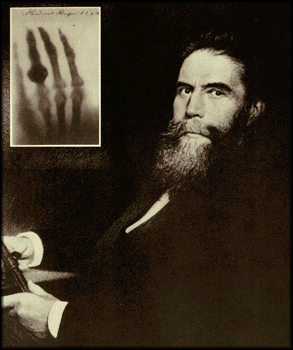Wilhelm Roentgen
source : http://www.accessexcellence.org/AE/AEC/CC/historical_background.html
 |
Wilhelm Conrad Roentgen (1845-1923)
On November 8, 1895, at the University of Wurzburg, Wilhelm Roentgen's
attention was drawn to a glowing fluorescent screen on a nearby table.
Roentgen immediately determined that the fluorescence was caused by invisible
rays originating from the partially evacuated glass Hittorf-Crookes tube
he was using to study cathode rays (i.e., electrons). Surprisingly, these
mysterious rays penetrated the opaque black paper wrapped around the tube.
Roentgen had discovered X rays, a momentous event that instantly revolutionized
the field of physics and medicine.
However, prior to his first formal correspondence to the University
Physical-Medical Society, Roentgen spent two months thoroughly investigating
the properties of X rays. Silvanus Thompson complained that Roentgen left
"little for others to do beyond elaborating his work." For his discovery,
Roentgen received the first Nobel Prize in physics in 1901. When later
asked what his thoughts were at the moment of his discovery, he replied
"I didn't think, I investigated. "It was the crowning achievement in a
career beset by more than its share of difficulties.
As a student in Holland, Roentgen was expelled from the Utrecht
Technical School for a prank committed by another student. Even after receiving
a doctorate, his lack of a diploma initially prevented him from obtaining
a position at the University of Wurzburg. He even was accused of having
stolen the discovery of X rays by those who failed to observe them.
Nevertheless, Roentgen was a brilliant experimentalist who never sought
honors or financial profit for his research. He rejected a title (i.e.,
von Roentgen) that would have provided entry into the German nobility,
and donated the money he received from the Nobel Prize to his University.
Roentgen did accept the honorary degree of Doctor of Medicine offered to
him by the medical faculty of his own University of Wurzburg. However,
he refused to take out any patents in order that the world could freely
benefit from his work. At the time of his death, Roentgen was nearly bankrupt
from the inflation that followed World War I.
|
Reference: "Wilhelm Conrad Roentgen and the Glimmer
of Light", in
Physics Today (November 1995), 25, by Howard H. Seliger
First observation by Roentgen of x-rays
November 8, 1895 - at Julius Maximilian University
in Wurzburg
He had been trying to find high frequency electromagnetic
radiation predicted by von Helmholtz. It had been proposed that these high
frequency emissions might be present in cathode ray tubes.
Earlier evidence for x-rays was found before Roentgen's
discovery. These earlier observations were not pursued by the original
experimenters. In fact, Roentgen repeated a measurement of an earlier experimenter.
In the late 1880s William Crookes found photographic
plates left near his cathode ray tube to have been unaccountably subjected
to "fogging".
1893 - Philipp Lenard saw crystals fluorescing that
had been placed outside of his high voltage cathode ray tubes. These effects
could not be attributed to the cathode rays directly. Lenard did not pursue
these studies because his research was interrupted by taking on administrative
duties.
1894 - Roentgen, probably from hearing of Lenard's
results, concluded these effects may have been due to the ultra-high frequency
waves that Helmholtz had predicted. He procured cathode ray tubes and even
asked Lenard for advice. By late fall of 1895 Roentgen had reproduced Lenard's
results. The effects of these rays was theoretically expected to be small.
Roentgen blocked out as much light as possible from his lab. He used a
fluorescent screen as a detector during his initial preparations he had
stored this screen a meter away from the cathode ray tube. He was trying
to eliminate even the light from the end of the cathode ray tube when he
noticed a glimmer of light in the corner of his eye. It was coming from
the fluorescent screen.
He determined that the rays were coming from the cathode
ray tube and were highly penetrating . These were not the cathode rays
themselves, but a new form of radiation which he called "x-strahlen". Roentgen
had used maximum accelerating voltages of 30-50 keV. He moved the screen
closer to the tube to its intended position and the bright green fluorescence
increased. he tried various items in the lab as absorbing media. He held
up a lead disk expecting to see the shadow of the disk and saw not only
the disk's shadow but also the bones of his hand!
He worked feverishly over the next 7 weeks confirming
his observations. By December 28, 1895 he had submitted a paper to
the Physical-Medical Society of Wurzburg. It was too late, however, to
be able to include his x-ray shadowgraphs. Over the next three days he
prepared enough photographs and preprints to mail to prominent physicists
in Germany, England, France and Austria. He mailed these packages himself
on New Year's Day, 1896. By January 5, 1896, Roentgen's discovery appeared
on the front page of the Viennese newspaper "Die Presse". Word of his discovery
spread very quickly. Within a few days of the appearnce of his x-ray photographs,
doctors in Philedelphia were already using x-rays to locate a bullet in
a man prior to surgery. By February the first x-ray treatment for cancer
was performed. Within 4 months Edison was manufacturing x-ray equipment!
